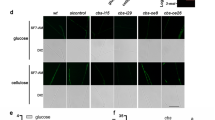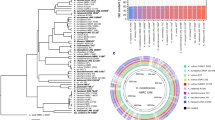Abstract
Komagataeibacter xylinus is an aerobic strain that produces bacterial cellulose (BC). Oxygen levels play a critical role in regulating BC synthesis in K. xylinus, and an increase in oxygen tension generally means a decrease in BC production. Fumarate nitrate reduction protein (FNR) and aerobic respiration control protein A (ArcA) are hypoxia-inducible factors, which can signal whether oxygen is present in the environment. In this study, FNR and ArcA were used to enhance the efficiency of oxygen signaling in K. xylinus, and globally regulate the transcription of the genome to cope with hypoxic conditions, with the goal of improving growth and BC production. FNR and ArcA were individually overexpressed in K. xylinus, and the engineered strains were cultivated under different oxygen tensions to explore how their overexpression affects cellular metabolism and regulation. Although FNR overexpression did not improve BC production, ArcA overexpression increased BC production by 24.0% and 37.5% as compared to the control under oxygen tensions of 15% and 40%, respectively. Transcriptome analysis showed that FNR and ArcA overexpression changed the way K. xylinus coped with oxygen tension changes, and that both FNR and ArcA overexpression enhanced the BC synthesis pathway. The results of this study provide a new perspective on the effect of oxygen signaling on growth and BC production in K. xylinus and suggest a promising strategy for enhancing BC production through metabolic engineering.
Key points
• K. xylinus BC production increased after overexpression of ArcA
• The young’s modulus is enhanced by the ArcA overexpression
• ArcA and FNR overexpression changed how cells coped with changes in oxygen tension
Graphical abstract








Similar content being viewed by others
Data availability
The data used to support the findings of this study are available from the corresponding author upon request.
References
Alexeeva S, Hellingwerf KJ, Teixeira de Mattos MJ (2003) Requirement of ArcA for redox regulation in Escherichia coli under microaerobic but not anaerobic or aerobic conditions. J Bacteriol 185(1):204–209. https://doi.org/10.1128/jb.185.1.204-209.2003
Bäckdahl H, Helenius G, Bodin A, Nannmark U, Johansson BR, Risberg B, Gatenholm P (2006) Mechanical properties of bacterial cellulose and interactions with smooth muscle cells. Biomaterials 27(9):2141–2149. https://doi.org/10.1016/j.biomaterials.2005.10.026
Cai Z, Kim J (2010) Bacterial cellulose/poly(ethylene glycol) composite: characterization and first evaluation of biocompatibility. Cellulose 17(1):83–91. https://doi.org/10.1007/s10570-009-9362-5
Gibson Daniel, G., Young, Lei, Chuang, Ray-Yuan, Venter, J., Craig, (2009) Enzymatic assembly of DNA molecules up to several hundred kilobases. Nat Methods 6:343–345. https://doi.org/10.1038/nmeth.1318
Gonidakis S, Finkel SE, Longo VD (2010) E coli hypoxia-inducible factor ArcA mediates lifespan extension in a lipoic acid synthase mutant by suppressing acetyl-CoA synthetase. Biol Chem 391(10):1139–1147
Green J, Crack JC, Thomson AJ, LeBrun NE (2009) Bacterial sensors of oxygen. Curr Opin Microbiol 12(2):145–151. https://doi.org/10.1016/j.mib.2009.01.008
He J, Zhao H, Li X, Su D, Zhang F, Ji H, Liu R (2018) Superelastic and superhydrophobic bacterial cellulose/silica aerogels with hierarchical cellular structure for oil absorption and recovery. J Hazard Mater 346:199–207. https://doi.org/10.1016/j.jhazmat.2017.12.045
Hestrin S, Schramm M (1954) Synthesis of cellulose by Acetobacter xylinum II Preparation of freeze-dried cells capable of polymerizing glucose to cellulose. Biochem J 58(2):345–352. https://doi.org/10.1042/bj0580345
Huang L-H, Liu Q-J, Sun X-W, Li X-J, Liu M, Jia S-R, Xie Y-Y, Zhong C (2020) Tailoring bacterial cellulose structure through CRISPR interference-mediated downregulation of GalU in Komagataeibacter xylinus CGMCC 2955. Biotechnol Bioeng 117(5):2165–2176. https://doi.org/10.1002/bit.27351
Hur DH, Choi W, Kim TY, Lee SY, Park J, Jeong K (2020) Enhanced production of bacterial cellulose in Komagataeibacter xylinus via tuning of biosynthesis genes with synthetic RBS. J Microbiol Biotechnol 30:1430–1435. https://doi.org/10.4014/jmb.2006.06026
Kang Y, Weber KD, Qiu Y, Kiley PJ, Blattner FR (2005) Genome-wide expression analysis indicates that FNR of Escherichia coli K-12 regulates a large number of genes of unknown function. J Bacteriol 187(3):1135–1160. https://doi.org/10.1128/jb.187.3.1135-1160.2005
Karlenius T, Tonissen K (2010) Thioredoxin and cancer: a role for thioredoxin in all states of tumor oxygenation. Cancers 2(2):209–232. https://doi.org/10.3390/cancers2020209
Koyama M, Helbert W, Imai T, Sugiyama J, Henrissat B (1997) Parallel-up structure evidences the molecular directionality during biosynthesis of bacterial cellulose. Proc Natl Acad Sci USA 94(17):9091–9095. https://doi.org/10.1073/pnas.94.17.9091
Lee S, Kim SM, Lee RT (2013) Thioredoxin and thioredoxin target proteins: from molecular mechanisms to functional significance. Antioxid Redox Signal 18(10):1165–1207. https://doi.org/10.1089/ars.2011.4322
Levanon SS, San KY, Bennett GN (2005) Effect of oxygen on the Escherichia coli ArcA and FNR regulation systems and metabolic responses. Biotechnol Bioeng 89(5):556–564. https://doi.org/10.1002/bit.20381
Liu M, Li S, Xie Y, Jia S, Hou Y, Zou Y, Zhong C (2017) Enhanced bacterial cellulose production by Gluconacetobacter xylinus via expression of Vitreoscilla hemoglobin and oxygen tension regulation. Appl Microbiol Biotechnol 102(3):1155–1165. https://doi.org/10.1007/s00253-017-8680-z
Loui C, Chang AC, Lu S (2009) Role of the ArcAB two-component system in the resistance of Escherichia coli to reactive oxygen stress. BMC Microbiol 9:183. https://doi.org/10.1186/1471-2180-9-183
Lynch AS, Lin ECC (1996) Transcriptional control mediated by the ArcA two-component response regulator protein of Escherichia coli: characterization of DNA binding at target promoters. J Bacteriol 178(21):6238. https://doi.org/10.1128/jb.178.21.6238-6249.1996
Mettert EL, Kiley PJ (2018) Reassessing the structure and function relationship of the O(2) sensing transcription factor FNR. Antioxid Redox Signal 29(18):1830–1840. https://doi.org/10.1089/ars.2017.7365
Nakatani T, Ohtsu I, Nonaka G, Wiriyathanawudhiwong N, Morigasaki S, Takagi H (2012) Enhancement of thioredoxin/glutaredoxin-mediated L-cysteine synthesis from S-sulfocysteine increases L-cysteine production in Escherichia coli. Microb Cell Fact 11:62. https://doi.org/10.1186/1475-2859-11-62
Parte FGB, Santoso SP, Chou C-C, Verma V, Wang H-T, Ismadji S, Cheng K-C (2020) Current progress on the production, modification, and applications of bacterial cellulose. Crit Rev Biotechnol 40(3):397–414. https://doi.org/10.1080/07388551.2020.1713721
Petersen N, Gatenholm P (2011) Bacterial cellulose-based materials and medical devices: current state and perspectives. Appl Microbiol Biotechnol 91(5):1277–1286. https://doi.org/10.1007/s00253-011-3432-y
Rajwade JM, Paknikar KM, Kumbhar JV (2015) Applications of bacterial cellulose and its composites in biomedicine. Appl Microbiol Biotechnol 99(6):2491–2511. https://doi.org/10.1007/s00253-015-6426-3
Rolfe MD, Beek AT, Graham AI, Trotter EW, Asif HMS, Sanguinetti G, de Mattos JT, Poole RK, Green J (2011) Transcript profiling and inference of Escherichia coli K-12 ArcA activity across the range of physiologically relevant oxygen concentrations. J Biol Chem 286(12):10147–10154. https://doi.org/10.1074/jbc.M110.211144
Salmon K, Hung S-p, Mekjian K, Baldi P, Hatfield GW, Gunsalus RP (2003) Global gene expression profiling in Escherichia coli K12: the effects of oxygen availability and FNR. J Biol Chem 278(32):29837–29855. https://doi.org/10.1074/jbc.M213060200
Salmon K, Hung S-p, Steffen NR, Krupp R, Baldi P, Hatfield GW, Gunsalus RP (2005) Global gene expression profiling in Escherichia coli K12: effects of oxygen availability and ArcA. J Biol Chem 280(15):15084–15096. https://doi.org/10.1074/jbc.M414030200
Shalel-Levanon S, San K-Y, Bennett GN (2005) Effect of ArcA and FNR on the expression of genes related to the oxygen regulation and the glycolysis pathway in Escherichia coli under microaerobic growth conditions. Biotechnol Bioeng 92(2):147–159. https://doi.org/10.1002/bit.20583
Tajima K, Imai T, Yui T, Yao M, Saxena I (2022) Cellulose-synthesizing machinery in bacteria. Cellulose 29(5):2755–2777. https://doi.org/10.1007/s10570-021-04225-7
Torres FG, Arroyo JJ, Troncoso OP (2019) Bacterial cellulose nanocomposites: an all-nano type of material. Mater Sci Eng C 98:1277–1293. https://doi.org/10.1016/j.msec.2019.01.064
Tseng C-P, Albrecht J, Gunsalus RP (1996) Effect of microaerophilic cell growth conditions on expression of the aerobic (cyoABCDE and cydAB) and anaerobic (narGHJI, frdABCD, and dmsABC) respiratory pathway genes in Escherichia coli. J Bacteriol 178(4):1094–1098. https://doi.org/10.1128/jb.178.4.1094-1098.1996
Ul-islam M, Khan T, Park JK (2012) Nanoreinforced bacterial cellulose-montmorillonite composites for biomedical applications. Carbohydr Polym 89(4):1189–1197. https://doi.org/10.1016/j.carbpol.2012.03.093
Unden G, Bongaerts J (1997) Alternative respiratory pathways of Escherichia coli: energetics and transcriptional regulation in response to electron acceptors. Biochim Biophys Acta Bioenerg 1320(3):217–234. https://doi.org/10.1016/S0005-2728(97)00034-0
Watanabe K, Yamanaka S (1995) Effects of oxygen tension in the gaseous phase on production and physical properties of bacterial cellulose formed under static culture conditions. Biosci Biotechnol Biochem 59(1):65–68. https://doi.org/10.1271/bbb.59.65
Funding
This study was funded by The National Key Research and Development Program of China (grant number 2021YFC2100800).
Author information
Authors and Affiliations
Contributions
ZC and HLL conceived and designed research. LXJ and WYT conducted experiments. HLL and LXJ analyzed data. HLL wrote the manuscript. XB contributed new reagents or analytical tools. All authors read and approved the manuscript.
Corresponding authors
Ethics declarations
Ethics approval
This article does not contain any studies with human participants or animals performed by any of the authors.
Conflict of interest
The authors declare no conflict of interest.
Additional information
Publisher's note
Springer Nature remains neutral with regard to jurisdictional claims in published maps and institutional affiliations.
Supplementary Information
Below is the link to the electronic supplementary material.
Rights and permissions
Springer Nature or its licensor holds exclusive rights to this article under a publishing agreement with the author(s) or other rightsholder(s); author self-archiving of the accepted manuscript version of this article is solely governed by the terms of such publishing agreement and applicable law.
About this article
Cite this article
Huang, LH., Li, XJ., Wang, YT. et al. Enhancing bacterial cellulose production with hypoxia-inducible factors. Appl Microbiol Biotechnol 106, 7099–7112 (2022). https://doi.org/10.1007/s00253-022-12192-7
Received:
Revised:
Accepted:
Published:
Issue Date:
DOI: https://doi.org/10.1007/s00253-022-12192-7




